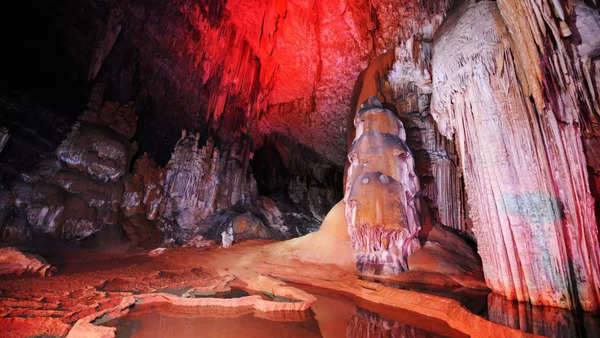Socotra’s isolation, about 380 kilometers south of the Arabian Peninsula and 240 kilometers east of Somalia, has resulted in a unique and highly endemic ecosystem.The archipelago is home to an astonishing variety of flora and fauna, with up to 37% of its 825 plant species, 90% of its reptile species, and 95% of its land snail species found nowhere else on the planet.
The most iconic symbol of Socotra’s otherworldly flora is the Dragon Blood Tree (Dracaena cinnabari), known for its distinctive umbrella-shaped canopy and the red resin it produces, which has been valued for centuries for its supposed medicinal properties. The island’s biodiversity extends beyond its famous trees; it includes a range of rare and unusual plants like the desert rose (Adenium socotranum), which has an unusually swollen trunk and bears vibrant pink flowers.

The Hoq cave in the Socotra archipelago gives off and eerie and otherworldly aura. Source: iStock
Socotra’s fauna is equally remarkable, with a high level of endemism among its bird, reptile, and marine life. The archipelago supports significant populations of land and sea birds, including several threatened species. The marine environment around Socotra is rich and diverse, hosting 253 species of reef-building corals, 730 species of coastal fish, and 300 species of crab, lobster, and shrimp.
The human history of Socotra is as fascinating as its natural history. The island has been known since ancient times, and its strategic location near major shipping routes has attracted various powers throughout history. The unique Soqotri language spoken by the islanders is a testament to Socotra’s long-standing cultural heritage and isolation.
Despite its natural wonders, Socotra faces challenges. The ongoing civil war in Yemen has led to concerns about the archipelago’s future, with the United Arab Emirates-backed Southern Transitional Council taking de facto control of the island. Conservation efforts are crucial to protect Socotra’s unique biodiversity and cultural heritage, recognized by UNESCO when it designated the archipelago as a World Heritage Site in 20082.
Socotra’s alien appearance and rich biodiversity have captured the imagination of scientists, conservationists, and travelers alike. Its unique landscape, shaped by millions of years of isolation, continues to be a source of scientific discovery and a priority for conservation. The Socotra archipelago remains a place of mystery and wonder, a natural treasure that holds secrets of evolution and the resilience of life in extreme environments. It is a vivid reminder of the diversity of life on our planet and the importance of preserving such irreplaceable natural sanctuaries for future generations.
‘Win’ For Houthis! Israel-Linked Ship Set To Sink In Red Sea After Being Attacked Twice

